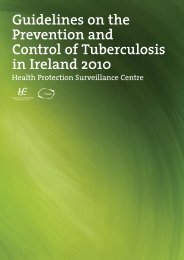Guidelines for the Early Clinical and Public Health Management of ...
Guidelines for the Early Clinical and Public Health Management of ...
Guidelines for the Early Clinical and Public Health Management of ...
Create successful ePaper yourself
Turn your PDF publications into a flip-book with our unique Google optimized e-Paper software.
<strong>Guidelines</strong> <strong>for</strong> <strong>the</strong> <strong>Early</strong> <strong>Clinical</strong> <strong>and</strong> <strong>Public</strong> <strong>Health</strong> <strong>Management</strong> <strong>of</strong> Bacterial Meningitis (including Meningococcal Disease)<br />
Summary <strong>of</strong> key recommendations <strong>for</strong> chemoprophylaxis (continued)<br />
Prophylaxis generally not indicated<br />
Prophylaxis is generally not indicated <strong>for</strong> contacts <strong>of</strong> a sporadic case in <strong>the</strong> following categories unless<br />
already identified as close contacts:<br />
• Primary or secondary school contacts<br />
• General medical or nursing care <strong>of</strong> a case<br />
• Work colleagues<br />
• Friends<br />
• Residents <strong>of</strong> a nursing home/residential homes<br />
• Kissing on cheek or mouth (intimate mouth-to-mouth kissing contacts should be <strong>of</strong>fered prophylaxis)<br />
• Food or drink sharing or similar low level <strong>of</strong> salivary contact<br />
• Travelling in next seat on same plane, train, bus or car<br />
• Post mortem contact with a case (o<strong>the</strong>r than per<strong>for</strong>ming an autopsy when may be indicated if<br />
exposed to aerosols <strong>and</strong> not wearing a mask).<br />
Timing <strong>of</strong> prophylaxis<br />
Ideally, chemoprophylaxis should be given to all contacts as soon as possible after diagnosis <strong>of</strong> a case.<br />
However, it is appropriate to administer chemoprophylaxis to close contacts who may not have come<br />
to notice initially, up to a month after <strong>the</strong> identification <strong>of</strong> <strong>the</strong> index case as carriage may persist <strong>for</strong> a<br />
long period.<br />
7.4 <strong>Public</strong> health actions after a case<br />
Risk assessment is needed<br />
For each notification <strong>of</strong> meningococcal disease, an individual event-specific risk assessment is needed<br />
to determine which individuals in contact with <strong>the</strong> case should be considered as “close contacts” <strong>and</strong><br />
<strong>for</strong> whom chemoprophylaxis is <strong>the</strong>re<strong>for</strong>e indicated.<br />
7.4.1 Cases requiring public health actions<br />
<strong>Public</strong> health actions should commence as soon as possible in all cases where <strong>the</strong> clinical diagnosis <strong>of</strong><br />
meningococcal meningitis or septicaemia is considered <strong>the</strong> most likely diagnosis. (See section 7.5)<br />
Although not meeting <strong>the</strong> case definition <strong>of</strong> a confirmed, probable or possible case, meningococcal infection <strong>of</strong> <strong>the</strong><br />
conjunctiva, without clinical evidence <strong>of</strong> sepsis, is considered an indication <strong>for</strong> public health action because it may<br />
precede invasive disease 59 or invasive meningococcal disease in a contact. 15 (See section 7.5)<br />
7.4.2 Cases not requiring public health actions<br />
When <strong>the</strong> public health doctor, in consultation with <strong>the</strong> clinician managing <strong>the</strong> case considers that diagnoses o<strong>the</strong>r<br />
than meningococcal disease are at least as likely, <strong>the</strong>n chemoprophylaxis is not indicated. This category includes<br />
cases treated with antibiotics whose probable diagnosis is viral meningitis. If fur<strong>the</strong>r evidence emerges to change <strong>the</strong><br />
diagnosis <strong>the</strong>n appropriate actions should be taken.<br />
Isolation <strong>of</strong> meningococci from sputum or from swabs taken from nasopharynx or genital tract, in <strong>the</strong> absence <strong>of</strong><br />
clinical evidence <strong>of</strong> sepsis, is not by itself an indication <strong>for</strong> public health action as asymptomatic carriage in <strong>the</strong><br />
respiratory <strong>and</strong> genital tract is common.<br />
Meningococcal pneumonia is not an indication <strong>for</strong> public health action but may carry a low risk <strong>of</strong> transmission in<br />
healthcare settings especially to <strong>the</strong> immunocompromised. 3<br />
-63-

















